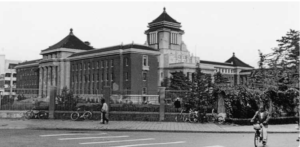This blog post focuses on a picture included in Bill Sewell’s book “Constructing Empire: The Japanese in Changchun, 1905-45”. Sewell focuses on the roof of the Changchun Hall of State to illustrate the “Asian Revival” architectural style which inspired many of the administrative buildings built in Japanese controlled Manchukuo in the 1930s. The view of the building presented shows how architecture during this period sought to promote Asian stylistic choices over European ones, most clearly seen in the style of roof. However, the choice to incorporate Chinese as well as Japanese styles reflects the shift of the Japanese government to the idea of Pan-Asianism.

Sewell notes that the roof of the Hall of State is built in a Japanese style, called “Imperial Crown” style. This was characterised by a tented roof, adding an Asian finish to an otherwise European-inspired building. This is evident in the picture of the Hall, where the building without the roof is indistinguishable from a Western administrative building. However, Sewell argues that the use of towers and a gentle slope for the remaining rooftop resembled Chinese instead of Japanese architecture. This is initially at odds with the idea of a colonial government constructing buildings for administration, but signifies the specific style of Japanese colonialism which was employed in Manchukuo.
Since the building was meant ‘to represent the entire country as chief government offices’ it is significant that the building incorporates elements of Chinese architecture, instead of being simply a melding of Japanese and Western styles. Sewell cites Ryue Nishizawa as suggesting that the choice of a Chinese style was in an attempt to project symbolism of harmony and sedateness, both represented in the long roof architecture chosen. This in turn would imply that the Japanese colonial government was seeking some form of legitimacy in the eyes of the Chinese population, as opposed to the colonial governments led by European nations.
The decision to seek legitimacy from the Chinese population of Manchukuo fits with the idea of Pan-Asianism, a driving ideology of Japanese expansion during the 1930s. The movement sought to unite Asian ethnic communities politically and economically to combat European imperialism. As such, the end goal of Japanese colonies was assimilation into the wider state, as opposed to the Western model of colonial governance. This ideology was already present within the colony of Korea, which was becoming assimilated as a province of Japan at the time the Hall of State was being constructed. It should also be noted that this style of roof was present in architecture designed in Korea during the 1920s, suggesting that the Japanese government was in favour of rolling out this style of roof across its new colonies, to combat European design while promoting a unified Asian idea of architecture.
Overall, the roof of the Hall of State offers an insight into how architecture could reflect government ideology, and seek to project both power and legitimacy. In this case, the Hall of State’s roof was designed to oppose European building styles, while attempting to win approval from the Chinese population of the province, as an early step in the creation of a Pan-Asian utopian entity.
Sources
Kornegay, Nate, ‘Traces of the Imperial Crown Style in Colonial Korea’, Transactions 92 (2017), pp. 21-30.
Sewell, Bill, Constructing Empire: The Japanese in Changchun, 1905-1945, (Vancouver, 2019), pp. 64-106.
Picture in Sewell, Constructing Empire, p. 82.